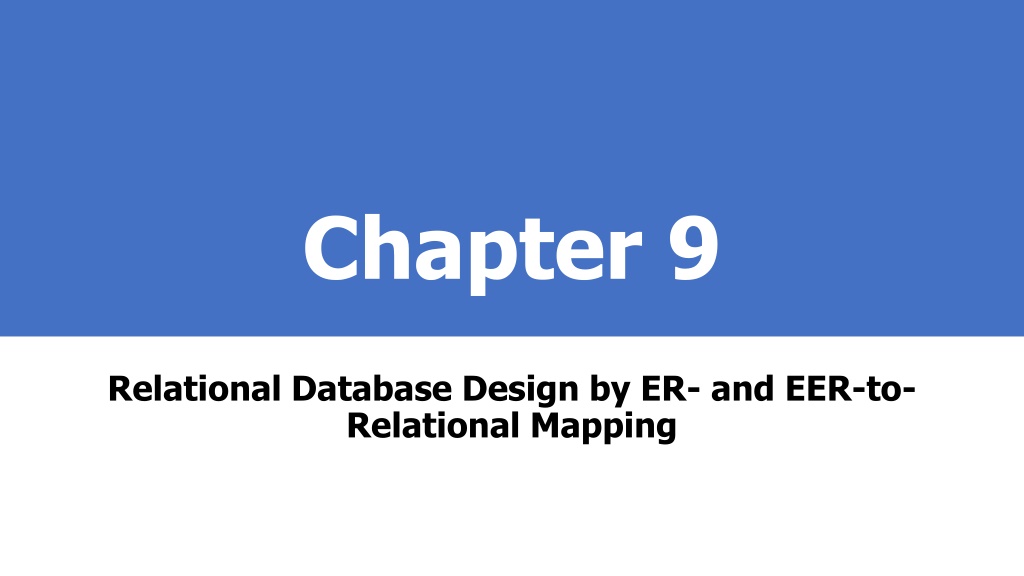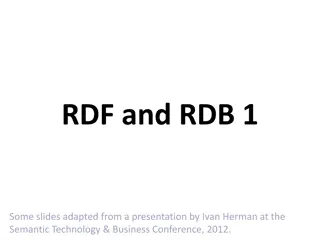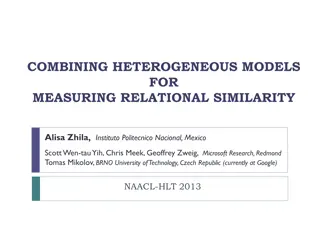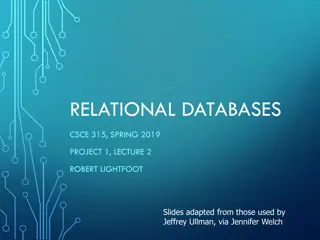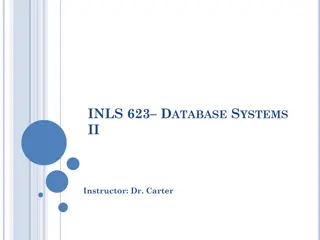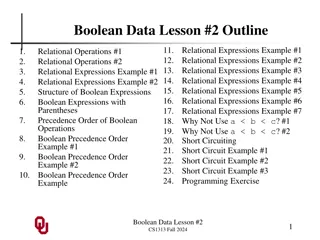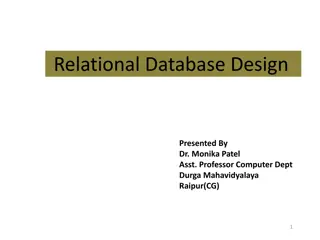Understanding Relational Database Design and Mapping Techniques
Explore the process of mapping Entity-Relationship (ER) and Enhanced Entity-Relationship (EER) models to relational databases. Learn about relational model concepts, mapping algorithms, and the goals and steps involved in the mapping process. Discover how to preserve information, maintain constraints, and minimize null values during the mapping process.
Download Presentation

Please find below an Image/Link to download the presentation.
The content on the website is provided AS IS for your information and personal use only. It may not be sold, licensed, or shared on other websites without obtaining consent from the author. Download presentation by click this link. If you encounter any issues during the download, it is possible that the publisher has removed the file from their server.
E N D
Presentation Transcript
Chapter 9 Relational Database Design by ER- and EER-to- Relational Mapping
Chapter Outline Relational Model Concepts ER-to-Relational Mapping Algorithm Step 1: Mapping of Regular Entity Types Step 2: Mapping of Weak Entity Types Step 3: Mapping of Binary 1:1 Relation Types Step 4: Mapping of Binary 1:N Relationship Types. Step 5: Mapping of Binary M:N Relationship Types. Step 6: Mapping of Multivalued attributes. Step 7: Mapping of N-ary Relationship Types. Mapping EER Model Constructs to Relations Step 8: Options for Mapping Specialization or Generalization. Step 9: Mapping of Union Types (Categories).
Relational Model Introduction The relational model represents the database as a collection of relations. Informally, each relation resembles a table of values When a relation is thought of as a table of values, each row in the table represents a collection of related data values. The table name and column names are used to help to interpret the meaning of the values in each row.
Introduction of the Mappings The goal of the chapter it to map ER models or EER models to relational models.
Goals during Mapping Preserve all information from the ER or EER models (that includes all attributes) Maintain the constraints to the extent possible (Relational Model cannot preserve all constraints- e.g., max cardinality ratio such as 1:10 in ER; exhaustive classification into subtypes, e.g., STUDENTS are specialized into Domestic and Foreign) Minimize null values
ER ER- -to to- -Relational Mapping Relational Mapping There seven steps required to map the ER-to-Relational model
ER ER- -to to- -Relational Mapping Algorithm Relational Mapping Algorithm Step 1: Mapping of Regular Entity Types. For each regular (strong) entity type E in the ER schema, create a relation R that includes all the simple attributes of E. Choose one of the key attributes of E as the primary key for R. If the chosen key of E is composite, the set of simple attributes that form it will together form the primary key of R. Example: We create the relations EMPLOYEE, DEPARTMENT, and PROJECT in the relational schema corresponding to the regular entities in the ER diagram. SSN, DNUMBER, and PNUMBER are the primary keys for the relations EMPLOYEE, DEPARTMENT, and PROJECT as shown.
Figure 9.1 The Figure 9.1 The ER conceptual ER conceptual schema schema diagram for the diagram for the COMPANY COMPANY database. database.
ER-to-Relational Mapping Algorithm (contd.) Step 2: Mapping of Weak Entity Types For each weak entity type W in the ER schema with owner entity type E, create a relation R & include all simple attributes (or simple components of composite attributes) of W as attributes of R. Also, include as foreign key attributes of R the primary key attribute(s) of the relation(s) that correspond to the owner entity type(s). The primary key of R is the combination of the primary key(s) of the owner(s) and the partial key of the weak entity type W, if any. Example: Create the relation DEPENDENT in this step to correspond to the weak entity type DEPENDENT. Include the primary key SSN of the EMPLOYEE relation as a foreign key attribute of DEPENDENT (renamed to ESSN). The primary key of the DEPENDENT relation is the combination {ESSN, DEPENDENT_NAME} because DEPENDENT_NAME is the partial key of DEPENDENT.
ER-to-Relational Mapping Algorithm (contd.) Step 3: Mapping of Binary 1:1 Relation Types For each binary 1:1 relationship type R in the ER schema, identify the relations S and T that correspond to the entity types participating in R. There are three possible approaches: 1. Foreign Key ( 2 relations) approach: Choose one of the relations-say S-and include a foreign key in S the primary key of T. It is better to choose an entity type with total participation in R in the role of S. Example: 1:1 relation MANAGES is mapped by choosing the participating entity type DEPARTMENT to serve in the role of S, because its participation in the MANAGES relationship type is total. 2. Merged relation (1 relation) option: An alternate mapping of a 1:1 relationship type is possible by merging the two entity types and the relationship into a single relation. This may be appropriate when both participations are total. 3. Cross-reference or relationship relation ( 3 relations) option: The third alternative is to set up a third relation R for the purpose of cross-referencing the primary keys of the two relations S and T representing the entity types.
ER-to-Relational Mapping Algorithm (contd.) Step 4: Mapping of Binary 1:N Relationship Types. For each regular binary 1:N relationship type R, identify the relation S that represent the participating entity type at the N-side of the relationship type. Include as foreign key in S the primary key of the relation T that represents the other entity type participating in R. Include any simple attributes of the 1:N relation type as attributes of S. Example: 1:N relationship types WORKS_FOR, CONTROLS, and SUPERVISION in the figure. For WORKS_FOR we include the primary key DNUMBER of the DEPARTMENT relation as foreign key in the EMPLOYEE relation and call it DNO. An alternative approach is to use a Relationship relation (cross referencing relation) this is rarely done.
ER-to-Relational Mapping Algorithm (contd.) Step 5: Mapping of Binary M:N Relationship Types. For each regular binary M:N relationship type R, create a new relation S to represent R. This is a relationship relation. Include as foreign key attributes in S the primary keys of the relations that represent the participating entity types; their combination will form the primary key of S. Also include any simple attributes of the M:N relationship type (or simple components of composite attributes) as attributes of S. Example: The M:N relationship type WORKS_ON from the ER diagram is mapped by creating a relation WORKS_ON in the relational database schema. The primary keys of the PROJECT and EMPLOYEE relations are included as foreign keys in WORKS_ON and renamed PNO and ESSN, respectively. Attribute HOURS in WORKS_ON represents the HOURS attribute of the relation type. The primary key of the WORKS_ON relation is the combination of the foreign key attributes {ESSN, PNO}.
ER-to-Relational Mapping Algorithm (contd.) Step 6: Mapping of Multivalued attributes. For each multivalued attribute A, create a new relation R. This relation R will include an attribute corresponding to A, plus the primary key attribute K-as a foreign key in R-of the relation that represents the entity type of relationship type that has A as an attribute. The primary key of R is the combination of A and K. If the multivalued attribute is composite, we include its simple components. Example: The relation DEPT_LOCATIONS is created. The attribute DLOCATION represents the multivalued attribute LOCATIONS of DEPARTMENT, while DNUMBER-as foreign key- represents the primary key of the DEPARTMENT relation. The primary key of R is the combination of {DNUMBER, DLOCATION}.
ER-to-Relational Mapping Algorithm (contd.) Step 7: Mapping of N-ary Relationship Types. For each n-ary relationship type R, where n>2, create a new relationship S to represent R. Include as foreign key attributes in S the primary keys of the relations that represent the participating entity types. Also include any simple attributes of the n-ary relationship type (or simple components of composite attributes) as attributes of S. Example: The relationship type SUPPY in the ER on the next slide. This can be mapped to the relation SUPPLY shown in the relational schema, whose primary key is the combination of the three foreign keys {SNAME, PARTNO, PROJNAME}
Figure 9.2 Result of mapping the COMPANY ER schema into a relational database schema.
FIGURE 3.17 TERNARY RELATIONSHIP: SUPPLY
FIGURE 3.17 TERNARY RELATIONSHIP: SUPPLY
Mapping the n Mapping the n- - ary relationship ary relationship type SUPPLY type SUPPLY
Summary of Mapping constructs and constraints Summary of Mapping constructs and constraints
Mapping of Generalization Mapping of Generalization and Specialization and Specialization Hierarchies Hierarchies to a Relational Schema to a Relational Schema
Mapping EER Model Constructs to Relations Step8: Options for Mapping Specialization or Generalization. Convert each specialization with m subclasses {S1, S2, .,Sm} and generalized superclass C, where the attributes of C are {k,a1, an} and k is the (primary) key, into relational schemas using one of the four following options: Option 8A: Multiple relations-Superclass and subclasses Option 8B: Multiple relations-Subclass relations only Option 8C: Single relation with one type attribute Option 8D: Single relation with multiple type attributes
Mapping EER Model Constructs to Relations Option 8A: Multiple relations-Superclass and subclasses Create a relation L for C with attributes Attrs(L) = {k,a1, an} and PK(L) = k. Create a relation Li for each subclass Si, 1 < i < m, with the attributesAttrs(Li) = {k} U {attributes of Si} and PK(Li)=k. This option works for any specialization (total or partial, disjoint of over-lapping). Option 8B: Multiple relations-Subclass relations only Create a relation Li for each subclass Si, 1 < i < m, with the attributes Attr(Li) = {attributes of Si} U {k,a1 ,an} and PK(Li) = k. This option only works for a specialization whose subclasses are total (every entity in the superclass must belong to (at least) one of the subclasses).
Mapping EER Model Constructs to Relations (contd.) Option 8C: Single relation with one type attribute Create a single relation L with attributes Attrs(L) = {k,a1, an} U {attributes of S1} U U {attributes of Sm} U {t} and PK(L) = k. The attribute t is called a type (or discriminating) attribute that indicates the subclass to which each tuple belongs Option 8D: Single relation with multiple type attributes Create a single relation schema L with attributes Attrs(L) = {k,a1, an} U {attributes of S1} U U {attributes of Sm} U {t1, t2, ,tm} and PK(L) = k. Each ti, 1 < I < m, is a Boolean type attribute indicating whether a tuple belongs to the subclass Si.
FIGURE 4.4 EER FIGURE 4.4 EER diagram notation diagram notation for an attribute for an attribute- - defined defined specialization on specialization on JobType. JobType.
Mapping the EER schema in Figure 4.4 using option 8A
Mapping the EER schema in Figure 4.4 using option 8C
FIGURE 4.3 (b) FIGURE 4.3 (b) Generalizing CAR Generalizing CAR and TRUCK into and TRUCK into the superclass the superclass VEHICLE. VEHICLE.
Mapping the EER schema in Figure 4.3b using option 8B.
FIGURE 4.5 An overlapping (non FIGURE 4.5 An overlapping (non- -disjoint) specialization. disjoint) specialization.
Mapping Figure 4.5 using option 8D with Boolean type fields Mflag and Pflag.
Different Options for Mapping Generalization Hierarchies Next Slide:Figure 9.5 Options for mapping specialization or generalization. (a) Mapping the EER schema in Figure 4.4 using option 8A. (b) Mapping the EER schema in Figure 4.3(b) using option 8B. (c) Mapping the EER schema in Figure 4.4 using option 8C. (d) Mapping Figure 4.5 using option 8D with Boolean type fields Mflag and Pflag.
Fig. 9.5: Different Fig. 9.5: Different Options for Options for Mapping Mapping Generalization Generalization Hierarchies Hierarchies - - summary summary
Mapping EER Model Constructs to Relations (contd.) Mapping of Shared Subclasses (Multiple Inheritance) A shared subclass, such as STUDENT_ASSISTANT, is a subclass of several classes, indicating multiple inheritance. These classes must all have the same key attribute; otherwise, the shared subclass would be modeled as a category. We can apply any of the options discussed in Step 8 to a shared subclass, subject to the restriction discussed in Step 8 of the mapping algorithm. Below both 8C and 8D are used for the shared class STUDENT_ASSISTANT.
FIGURE 4.7 A FIGURE 4.7 A specialization specialization lattice with lattice with multiple multiple inheritance for a inheritance for a UNIVERSITY UNIVERSITY database. database.
FIGURE 9.6 Mapping the EER specialization lattice in Figure 4.7 using multiple options.
Mapping EER Model Constructs to Relations (contd.) Step 9: Mapping of Union Types (Categories). For mapping a category whose defining superclass have different keys, it is customary to specify a new key attribute, called a surrogate key, when creating a relation to correspond to the category. In the example below we can create a relation OWNER to correspond to the OWNER category and include any attributes of the category in this relation. The primary key of the OWNER relation is the surrogate key, which we called OwnerId.
FIGURE 4.8 Two categories (union types): OWNER and REGISTERED_VEHICLE.
FIGURE 9.7 FIGURE 9.7 Mapping the Mapping the EER categories EER categories (union types) in (union types) in Figure 4.8 to Figure 4.8 to relations. relations.
Mapping Mapping Exercise Exercise- -1 1 Exercise 9.4 : Map this schema into a set of relations.
Mapping Mapping Exercise Exercise- -2 2 FIGURE 9.9 EER diagram for a car dealer
Chapter Summary ER-to-Relational Mapping Algorithm Step 1: Mapping of Regular Entity Types Step 2: Mapping of Weak Entity Types Step 3: Mapping of Binary 1:1 Relation Types Step 4: Mapping of Binary 1:N Relationship Types. Step 5: Mapping of Binary M:N Relationship Types. Step 6: Mapping of Multivalued attributes. Step 7: Mapping of N-ary Relationship Types. Mapping EER Model Constructs to Relations Step 8: Options for Mapping Specialization or Generalization. Step 9: Mapping of Union Types (Categories).
